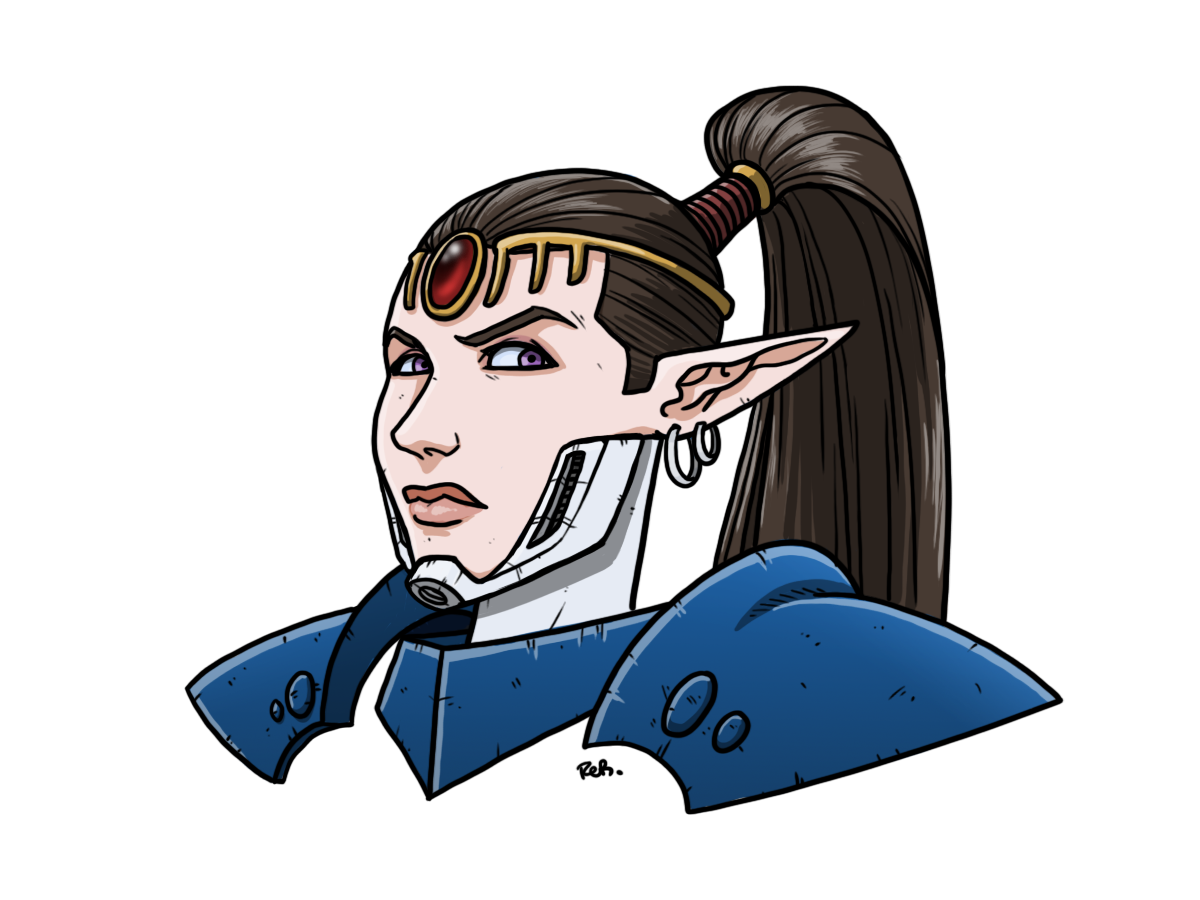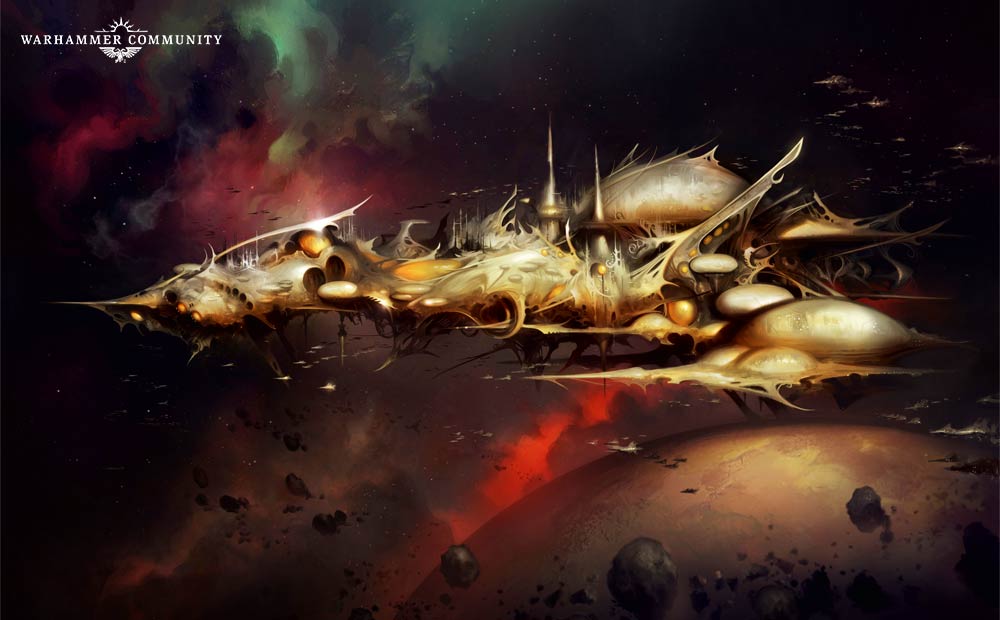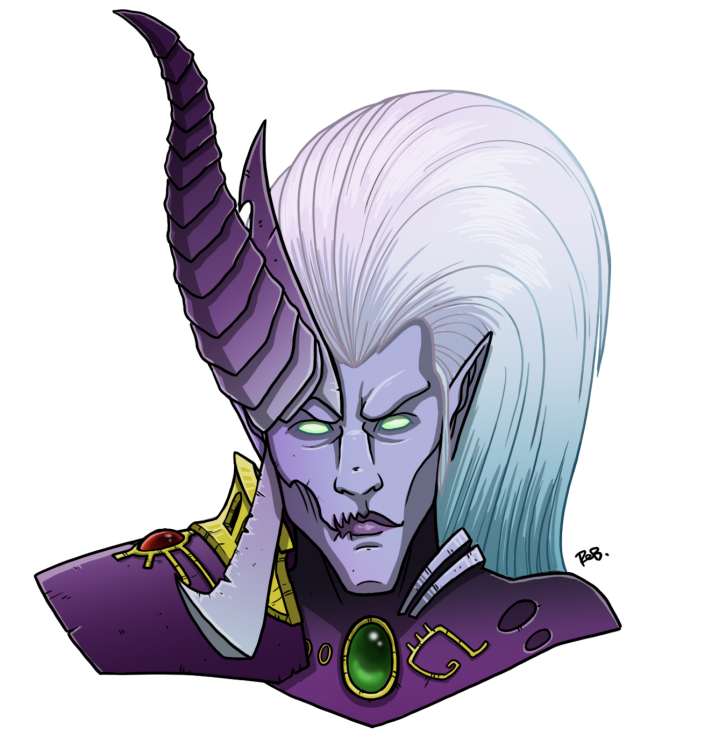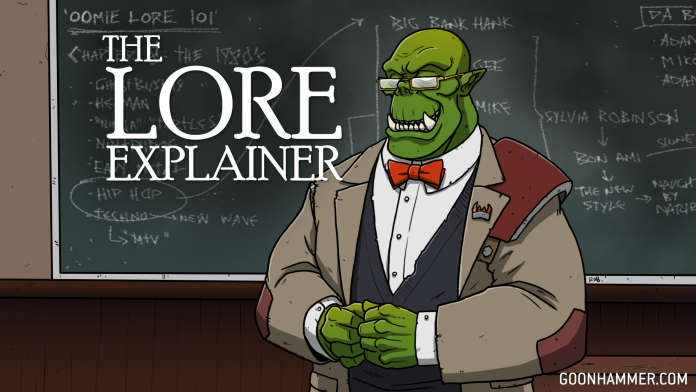In Lore Explainer, we take a deep look at the lore behind our favorite games, movies, and books, and talk about the story behind them and sum up what you need to know and how you can find out more.
Welcome to the Lore Explainer, friends. Come in, come in, take a seat by the fire and get comfortable as Wise Master Keewa explains some of Warhammer 40,000’s cavernous and oft-confusing lore. As it turns out, if you have a universe built and defined by hundreds of people over the space of thirty five years, things can get complicated.
The fall of the Aeldari is certainly one of the most pivotal events in the greater Warhammer cosmology, sending its devastating ripples out across the entire galaxy and shaping the course of humanity and the Aeldari, but the event itself – and its timing – are a bit confusing. So in this article we’ll dive into what actually happened.
Who Are the Aeldari?
The Aeldari, or “Eldar” if you started playing before 8th edition, are an unimaginably ancient species of humanoid aliens which dominated the entire galaxy in the time before the rise of mankind. They live a very long time, they’re tall, they’re slender, they have pointy ears… They’re Warhammer 40,000’s elves, basically.

The Aeldari Empire
In the power vacuum following The War In Heaven (itself the subject of a future Lore Explainer), the Aeldari were able to expand and thrive. Eventually, the Eldar Empire spanned the stars as a paragon of peace and prosperity, for although there were other advanced races in existence at the time none had the power to threaten the might of the Aeldari. Although they warred occasionally with lesser races and one another, the Aeldari did not fear death, for they were the beneficiaries of a divine boon: Upon dying, their souls would dissolve into the warp, hanging out with their gods for a little while, probably playing Bridge or something, before being reborn into a new body. As their power grew, the Aeldari developed ingenious automata capable of performing all the work functions necessary to sustain their civilisation through the aeons. They were freed from having to perform any labours at all! Sounds great, right? The Aeldari certainly thought so, but their overreliance on automata to do… well, basically everything caused more than a few problems.
Since they no longer needed to work, the Aeldari were free to do whatever they liked, all the time. A race imbued with a very strong natural curiosity, they used their newfound free time to do lots and lots of learning, uncovering many secrets regarding the nature of the universe, accessing the ancient Webway construct, and using it to effortlessly traverse the galaxy in order to expand their horizons even further. Although they were endlessly curious, the Aeldari were also an incredibly arrogant species, considering all other life in the universe to be beneath their consideration.

Permanent Vacation
While some Aeldari used their permanent vacation and obsessive personalities to attempt to understand the nature of the universe, still others focused on exploring the realm of sensation, indulging more and more heavily in their “earthly” desires, throwing themselves into 24/7 Eyes Wide Shut levels of debauchery. These space elves were having a grand old time fuelled by food, drugs, and sex, but it couldn’t last. Evidently, Aeldari were subject to the same hedonic treadmill as us mere mortals, and over millennia they became bored once again, the endless opulent orgies becoming as exciting as standing in line at the post office.
Bored by their newfound baseline of indulgence, the Aeldari began to seek more and more extreme sensations. With their society becoming increasingly corrupt and having exhausted their capacity for pleasure, the Aeldari turned to pain, and the warped, sadistic pleasure of inflicting it upon each other, forming cults to pursue these dark desires. Orgies of pleasure transformed into orgies of violence and cruelty. And while that all sound bad enough on its own, the Aeldari were also sowing the seeds of their own destruction – though they generally had no idea this was happening. As a very psychically attuned species, each act of excess and sadism was having a small effect – not only in the material world, but in the Warp as well.
Eventually these sadistic cults turned to outright murder in order to feed their relentless hunger for the extreme. Roving gangs stalked the streets of Aeldari cities, torturing and murdering any they encountered. After a while, gladiatorial arenas began to spring up, allowing tens of thousands of Aeldari to engage their vicarious lust for cruelty and bloodshed at once. As you can imagine, such a state of affairs is not particularly conducive to a peaceful, stable society.

Because of this, groups of Aeldari began to abandon their homeworlds, seeking refuge from their society’s horrifying decline into madness, with two groups of particular significance. One group, termed the Exodites, fled to unsettled verdant worlds at the very edge of Aeldari space in stark rejection of both their society’s decline into decadence and its overreliance on automata. These Exodites pursued a harder life of toil and subsistence reminiscent of their ancient past, while also doing cool shit like riding around on dinosaurs.
The other group fled the decline of their species onboard planet-sized spaceships called Craftworlds. Because they’re like… worlds.. on spacecraft. Geddit? These Aeldari smartly decided to keep the automation that made life easy, but figured that civilisation on the home worlds was boned and wanted out before something truly terrible happened.
Something Truly Terrible Happens
As it turns out, the Craftworlders’ desire to get out of Dodge proved to be quite prescient. Unbeknownst to the trillions of Aeldari getting their kicks from violence and debauchery, the cumulative psychic effect of their deprivations was growing within the warp. As this growth accelerated, the most psychically gifted of their species became plagued with visions of an embryonic entity slumbering in the immaterium, a being created as a gestalt manifestation of the Aeldari’s sickness, growing ever larger.
Perhaps as a result of these visions, the descent into madness was accelerated in turn, reaching its zenith as laughing Aeldari slew their kin and feasted on their bodies, which is generally regarded as a bit of a faux-pas. In one horrifying instant, the warp entity was finally born, the violence of its creation tearing a titanic hole right through the warp and into realspace.
The newborn, named Slaanesh or She Who Thirsts, unleashed a devastating psionic scream that radiated outwards from the locus of its birth, the Aeldari homeworlds. In an instant, the psychic defences of billions of Aeldari were annihilated and they howled in anguish before dropping dead, their souls torn from their bodies and sucked up by Slaanesh, supercharging the new god like some kind of dead space elf Red Bull.
Many of the fleeing Craftworlds were also overwhelmed by the onrushing psychic barrage, instantly killing all those aboard and adding their souls to the consumed. Only the furthest flung, the earliest departures – Exodites and first Craftworlders (those who had seen the end long before it came) – and the Aeldari who’d taken refuge in the labyrinthine Webway managed to avoid being blinked out of existence. Even so, the pain those Eldar felt was excruciating. Although trillions of Aeldari died in the cataclysm, they were not the only ones affected either: Billions of humans and other sentient creatures living on worlds near the Aeldari Homeworlds had their lives snuffed out by the catastrophe.
The tumultuous wound left in realspace by Slaanesh’s violent birth would eventually expand to consume all of the Aeldari worlds, forming the Eye of Terror, a massive warp storm and a rift in realspace that would later be home to all manner of Chaos forces. After this the once-pleasant Aeldari homeworlds (now named Crone Worlds) became unsettling dead planets, lit by roiling swirls of alien colours, filled with ruins, and inhabited by demons – like an interstellar Blackpool.
Having consumed trillions of souls, Slaanesh set about murdering the numerous Aeldari gods inhabiting the warp. The Crone goddess Morai-Heg, the Maiden Lileath, and the Phoenix King Asuryan were all unable to stand before She Who Thirsts, falling and being consumed one-by-one. Even Kaela-Mensha-Khaine, the mighty Aeldari god of violence, was unable to overcome the foe, battling valiantly until the newborn god’s power shattered him into fragments. Although the pantheon was destroyed, not all of the gods were killed: The crafty Laughing God Cegorach managed to escape, slipping away like a guest leaving a bad party. In addition, some Aeldari believe that the mother goddess Isha also survived the fall, and was spirited from the jaws of Slaanesh by Nurgle – the chaos god of decay – before being imprisoned within his palace.
Notes
While all of this sounds like it should have happened millions of years ago, in the 40k timeline the birth of Slaanesh and the creation of the Eye of Terror is the inciting incident for the Great Crusade. This all happens in the early 30th millennium of the Terran calendar and the resulting blast in the empyrean blows away the warp storms which had engulfed much of the galaxy and made warp travel massively unsafe. The Emperor takes notice, and decides it’s finally time to make his move. In that sense the death of the Eldar paved the way for the ascendance of humanity… well, its second ascendance. The biggest issue here is where all this fits in with the Dark Age of Technology and Age of Strife, presumably the point where humanity is also ascendant and conquering the stars but the Aeldari are still doing their thing and becoming more depraved.
![]()
Down But Not Out
In the millennia since The Fall the Aeldari species limps on, a mere whisper of its former power and glory. Disparate Craftworlds now hold most of their population, sailing the interstellar gulf and acting as arks of refuge for their dwindling number. Very few are alive now that remember the majesty of the Aeldari before their fall. In order to protect themselves from falling into excess and depravity, the Craftworld Aeldari have developed a byzantine system of “paths”, enabling them to channel their obsessive personalities towards more productive ends. For example: A single Aeldari might spend many human lifetimes single-mindedly practising to be the best furniture maker the galaxy has ever seen, producing chair after chair honing this skill. By doing endless wood carving instead of getting wasted and murdering his family, this Aeldari prevents another, smaller fall. Since Slaanesh was hanging out in the warp, mouth wide open and hungry for some Eldar Souls, the quasi-immortality the Aeldari previously enjoyed was lost to them. Whereas previously the Aeldari had gone to the cosmic hang-out to chill with their gods, now as soon as their soul entered the warp, they’d be slurped up in a flash. This desperate necessity lead to the development of ways to prevent their souls from entering the warp, and thus Slaanesh’s hungry gob, when they died.
Each of the different Aeldari groups handles this newfound fear of death differently. The Exodites believe that when they die, their spirits are sucked up by the giant webs of psychoactive crystal spanning their worlds, simply amalgamating into the World Spirit of the planet they live on. The enigmatic Harlequins claim divine protection from their patron god, the Laughing God Cegorach, as he evaded Slaanesh’s hungry attention. The sadistic Drukhari live in the Webway, continuing the extreme cruelty of their forebears, these “Dark Eldar” believe that through inflicting suffering they can stave off the predations of the being that hounds them.
For Craftworlds, the answer lies in the spirit stones they carry. Each Craftworld contains at its heart an Infinity Circuit, a sort of waiting room in which the souls of deceased Aeldari can reside, protected from falling victim to She Who Thirsts. In order to stop their souls from simply entering the warp by themselves when they die, Similar to the psychoactive crystal matrices of the Exodites, Craftworlders carry Spirit Stones in their attire and armour, and upon dying the soul of the wearer is instantly captured inside this stone, invulnerable to the predations of Chaos. These stones are then harvested and returned to each Craftworld’s Infinity Circuit. Like collecting fallen soldiers’ dog tags, if the dog tags were huge gemstones.
If things become really dire, Aeldari Spiritseers can yank some of the souls out of the Infinity Circuit and stick them in giant wraithbone bodies to fight on the Craftworld’s behalf. Perhaps unsurprisingly, the Aeldari view the practise of pulling dear old granny out of limbo and making her re-experience the horrors of war as rather distasteful.
Notes
The Drukhari lore suggests that it’s not clear whether Eldar souls ever went anywhere but the Warp, but now they’re very certain that their souls go to Slaanesh when they die. The Drukhari stave this off by inflicting pain on others, and if they don’t, they actually start to wither physically and psychically. But as always, the relief they feel from their sadistic tortures is temporary. Note as well that because of Slaanesh, the Warp is basically a really bad place for Eldar to be and so they do not travel the warp in the same way as humanity – instead they use the Webway for their travel (itself the subject of a future Lore Explainer).
It’s also worth noting that the timeline on The Fall and the birth of Slaanesh is pretty wonky – the official date of it is something like 750 M30, but in some of the Horus Heresy novels they speak of the event happening thousands of years prior, which doesn’t line up. That said, the Fall could have happened a bit earlier, but it’s an important part of the process for kickstarting the Emperor’s Great Crusade.

A Faint Glimmer of Hope
In recent times, a group called the Ynnari have risen from among the Aeldari, lead by the enigmatic Yvraine, Herald of Ynnead. Ynnead is the long-speculated/prophesied Aeldari god of death, claimed by Yvraine to be growing within the heart of each Craftworld. They never had a god of death before, y’see, since they didn’t actually die for real. Just as the cumulated depravity of the Aeldari of long ago fed and nurtured the embryonic Slaanesh, Yvraine claims that the souls of the dead being gathered within the Infinity Circuits will do the same for Ynnead, eventually allowing him to spring forth and defeat Slaanesh once and for all. The appearance of the spooky and enigmatic Yncarne, Avatar of Ynnead has convinced many notable Aeldari to pledge themselves to this new cause, this cosmic Hail Mary, kindling fresh hope for the refugee species. There’s more to say about the Ynnari, but that is also the subject for a future Lore Explainer – and their lore is pretty nascent and flexible at the moment anyways.
Paving the Way for the Imperium
The Fall was a pretty bad day for the Aeldari, dooming them to wander the universe as a broken species and all. But it also set things up for Humanity, clearing away the warp storms which prevented warp travel and kickstarting the Emperor’s Great Crusade. This would in turn lead to humanity’s ascension as the dominant species of the galaxy, and act as a further kick to the already-down Aeldari, especially when that crusade saw humans claiming and cultivating the Maiden Worlds the Aeldari had fought so hard to protect and keep pristine.
Have any questions or feedback? Got a lore topic you’d like us to explore in a future Lore Explainer? Drop us a note in the comments below or email us at contact@goonhammer.com.


